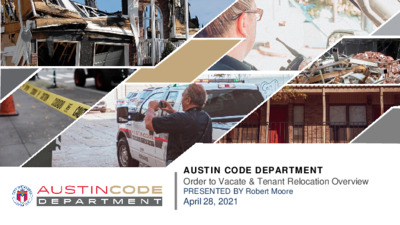Presentation - Austin Code's Process to Vacate & Relocate — original pdf
Backup

AUSTIN CODE DEPARTMENT Order to Vacate & Tenant Relocation Overview PRESENTED BY Robert Moore April 28, 2021 Overview • What authority speaks to issuing an order to vacate? • When is there a need for an order to vacate? • What happens when an order to vacate is issued? • What happens when Owner responsibility fails? What authority speaks to issuing an order to vacate? Texas Local Government Code Sec. 214.001 Authority Regarding Substandard Building. (a) A municipality may, by ordinance, require the vacation, relocation of occupants, securing, repair, removal, or demolition of a building that is: (1) dilapidated, substandard, or unfit for human habitation and a hazard to the public health, safety, and welfare;… What authority speaks to issuing an order to vacate? Texas Local Government Code Sec. 54.036 Functions. A commission panel may: (1) order the repair, within a fixed period, of building found to be in violation of an ordinance; (2) declare a building substandard in accordance with the powers granted by this subchapter; (3) order, in an appropriate case, the immediate removal of persons or property found on private property, enter on private property to secure the removal if it is determined that conditions exist on the property that constitute a violation of an ordinance, and order action to be taken as necessary to remedy, alleviate, or remove any substandard building found to exist;… What authority speaks to providing relocation assistance? Texas Property Code - PROP § 21.046. Relocation Assistance Program (b) This state or a political subdivision of this state shall, as a cost of acquiring real property, pay moving expenses and rental supplements, make relocation payments, provide financial assistance to acquire replacement housing, and compensate for expenses incidental to the transfer of the property if an individual, a family, the personal property of a business, a farming or ranching operation, or a nonprofit organization is displaced in connection with the acquisition. (e) If a person moves or discontinues the person's business, moves personal property, or moves from the person's dwelling as a direct result of code enforcement, rehabilitation, or a demolition program, the person is considered to be displaced because of the acquisition of real property. What authority does the City have to recover its costs? Texas Local Government Code Sec. 214.001(m) and (n): (m) If the building is not vacated, secured, repaired, removed, or demolished, or the occupants are not relocated within the allotted time, the municipality may vacate, secure, remove, or demolish the building or relocate the occupants at its own expense. This subsection does not limit the ability of a municipality to collect on a bond or other financial guaranty that may be required by Subsection (k). (n) If a municipality incurs expenses under Subsection (m), the municipality may assess the expenses on, and the municipality has a lien against, unless it is a homestead as protected by the Texas Constitution, the property on which the building was located. The lien is extinguished if the property owner or another person having an interest in the legal title to the property reimburses the municipality for the expenses. The lien arises and attaches to the property at the time the notice of the lien is recorded and indexed in the office of the county clerk in the county in which the property is located. The notice must contain the name and address of the owner if that information can be determined with a reasonable effort, a legal description of the real property on which the building was located, the amount of expenses incurred by the municipality, and the balance due. When is there a need for an order to vacate? • Tenants/Occupants are in immediate danger. • Austin Code will be making the recommendation • Displacement is a last resort What happens when an order to vacate is issued? Austin Code first looks to the owner to offer assistance and services. What happens when Owner responsibility fails? ETRRP – Emergency Tenant Response & Relocation Plan The determination to activate the ETRRP is usually made by the Director of the Austin Code Department. However, any City Department may request an activation response to emergencies involving tenant displacement where the owner or manager of the property is unable or unwilling to provide shelter and resources to tenants. Departments Involved in the emergency response team could include : • Austin Code Department (ACD) • Austin Fire Department (AFD) • Austin Police Department (APD) • Health & Human Services (HHS) • Homeland Security & Emergency Management (HSEM) • Neighborhood Housing & Community Development (NHCD) • Communications & Public Information Office (CPIO) • Office of Real Estate Services (ORES) What happens when Owner responsibility fails? Basic Action Plan • Determine the scope and impact of the incident • Coordinate initial operations • Contact Emergency Response Team • Communicate information and instructions • Offer tenants assistance • Monitor and re-evaluate conditions Cost Assessment Example of a Cost Assessment for relocating one side of a duplex Unit Estimated Rental Assistance Payment (RAP) Estimated Moving Estimated Deposits Estimated Emergenc y Housing Estimated Subtotal 10% Contingen cy Estimated Total A $ 38,350.00 $1,600.00 $3,000.000 $9,000.00 $51,950.00 $5,195.00 $57,145.00 Rounded $60,000 Assumptions: • One family displaced • RAP is based on 42 month differential • Comparable rent = $1,500 • Estimated Annual Income = $25,000; Gross Assumptions: • Moving costs based on 2016 FHWA Fixed Residential Moving Schedule • Emergency housing limited to 60 days at $150 a night • RAP funds can only be claimed if the tenant leases Monthly Income = $625 up to the comparable rent amount THANK YOU Any questions?